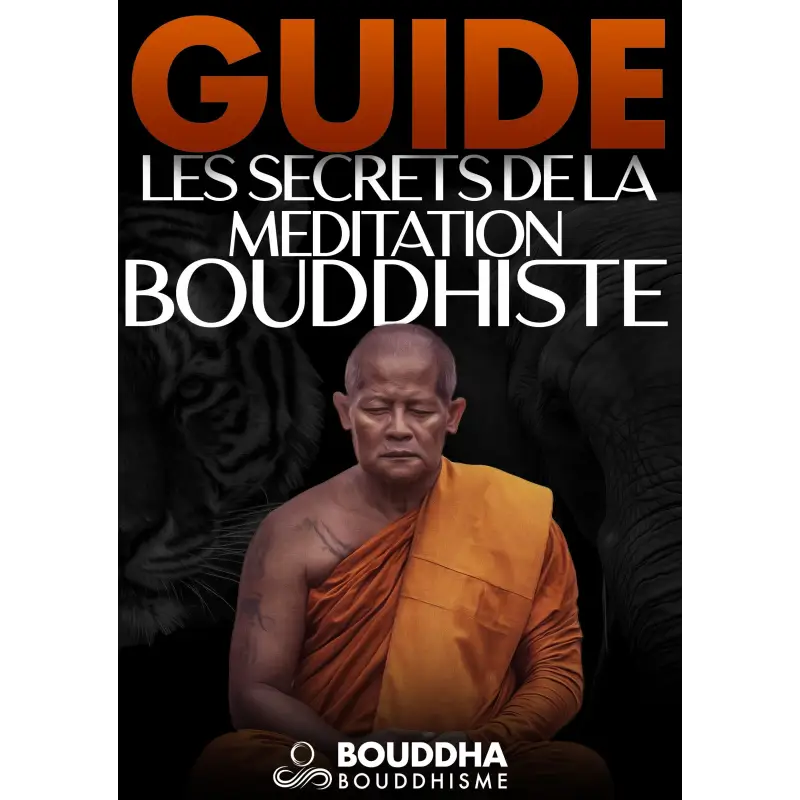What is the holy book of Buddhists?
What is the holy book of Buddhists?
The importance of sacred texts in Buddhism
Buddhism is a religion whose teachings are based on the words and writings of Buddha, the founder of Buddhism. Although Buddhism does not have a single holy book, there are several sacred texts that are considered sources of inspiration and guidance for Buddhist practitioners. /p>
The Buddhist sacred texts contain the Buddha's teachings on the path to enlightenment, meditation, compassion and other important aspects of Buddhist practice. They are considered valuable guides for those seeking to achieve enlightenment and follow the path of the Buddha.
Buddhist sutras
The sutras are the most important and most revered texts in Buddhism. They contain the direct words of the Buddha and have been passed down from generation to generation since his time. The sutras describe the Buddha's teachings on topics such as impermanence, emptiness, compassion, and the nature of mind.
These texts are often interpreted and commented on by Buddhist masters in order to facilitate the understanding of the Buddha's teachings. They are considered a source of inspiration and guidance for Buddhist practitioners.
The sutras are written in different languages, including Pali and Sanskrit, and are translated into many languages around the world.
Comment texts
In addition to sutras, there are also commentary texts that have been written by Buddhist thinkers and scholars over the centuries. These commentary texts serve to explain and clarify the teachings of the Buddha contained in the sutras.
Commentary texts offer in-depth analyzes and interpretations of the sutras and help practitioners deepen their understanding of Buddhist teachings. They are often used as study materials in monasteries and Buddhist centers.
Some of the best-known commentary texts are those written by thinkers such as Nagarjuna, Vasubandhu and Dogen Zenji, who brought their own perspective and wisdom to the interpretation of Buddhist sutras.
The sacred texts of Theravada Buddhism
Theravada Buddhism, which is practiced primarily in Southeast Asia, has its own sacred texts that are specific to this tradition.
The Tipitaka, also known as the Tripitaka, is the main collection of Theravada sacred texts. It is written in Pali and is considered the epitome of the Buddha's teachings.
The three parts of Tipitaka
The Tipitaka consists of three main parts: the Vinaya Pitaka, the Sutta Pitaka and the Abhidhamma Pitaka.
The Vinaya Pitaka contains the rules and monastic precepts of Theravada Buddhism. It provides detailed guidelines on personal conduct, rules of community life, and monastic procedures.
The Sutta Pitaka contains the discourses of the Buddha and the teachings given to the disciples. It is divided into five collections called Nikayas, which cover different aspects of Buddhist doctrine.
The Abhidhamma Pitaka is a philosophical analysis of Buddhist teachings. It examines in detail key concepts such as perception, consciousness, mental factors and the nature of reality.
Post-canical texts
In addition to the Tipitaka, there are also post-canic texts that were written by later Theravada thinkers. These texts offer additional commentary, analysis, and elaboration on the Buddha's teachings.
Some of the best-known post-canal texts include the commentaries on the Dhammapada and the Visuddhimagga, as well as the writings of thinkers such as Buddhaghosa and Buddhadasa Bhikkhu.
These texts are important for deepening understanding of Buddhist teachings and are often studied in Theravada monasteries and Buddhist centers.
The sacred texts of Mahayana Buddhism
Mahayana Buddhism, which is practiced primarily in East Asia, also has its own sacred texts that are specific to this tradition.
The Lotus Sutra, also known as the Lotus Sutra of Wonderful Law, is one of the most important texts of Mahayana Buddhism. It teaches the Buddha's vision of universal enlightenment and infinite compassion.
The Mahayana sutras
In addition to the Lotus Sutra, there are many other Mahayana sutras that are revered in this tradition.
The Heart Sutra, the Diamond Sutra, the Equivalence Sutra and the Nirvana Sutra strong> are among the best-known Mahayana sutras.
These sutras present teachings on the nature of enlightenment, emptiness, compassion and bodhichitta, which is the mind of enlightenment.
Commentary texts and treatises
Just as in Theravada Buddhism, Mahayana Buddhism has its own commentary texts and treatises that were written by later Mahayana thinkers.
These texts offer additional interpretations and elaborations on the Mahayana teachings and help practitioners deepen their understanding of the bodhisattva path and universal enlightenment.
The writings of masters such as Nagarjuna, Asanga, Vasubandhu and Dogen Zenji are often studied in Mahayana Buddhist centers and are considered a source of inspiration for Mahayana practitioners.
Conclusion: The wealth of Buddhist sacred texts
In conclusion, although Buddhism does not have a single holy book, it has a rich collection of sacred texts that are revered and studied by Buddhists throughout the world. whole world. These texts offer profound teachings on the path to enlightenment, meditation, compassion and other important aspects of Buddhist practice.
Whether through the sutras of Theravada Buddhism, the Lotus Sutra of Mahayana Buddhism, or the commentaries and treatises written by later thinkers, these sacred texts are a source of inspiration and guidance for Buddhist practitioners who seek to achieve enlightenment and follow the path of the Buddha.
Reading and studying these texts can help practitioners deepen their understanding of the Buddha's teachings and cultivate their own enlightenment.
What is the holy book of Buddhists?
The importance of sacred texts in Buddhism
Buddhism is a religion whose teachings are based on the words and writings of Buddha, the founder of Buddhism. Although Buddhism does not have a single holy book, there are several sacred texts that are considered sources of inspiration and guidance for Buddhist practitioners. /p>
The Buddhist sacred texts contain the Buddha's teachings on the path to enlightenment, meditation, compassion and other important aspects of Buddhist practice. They are considered valuable guides for those seeking to achieve enlightenment and follow the path of the Buddha.
Buddhist sutras
The sutras are the most important and most revered texts in Buddhism. They contain the direct words of the Buddha and have been passed down from generation to generation since his time. The sutras describe the Buddha's teachings on topics such as impermanence, emptiness, compassion, and the nature of mind.
These texts are often interpreted and commented on by Buddhist masters in order to facilitate the understanding of the Buddha's teachings. They are considered a source of inspiration and guidance for Buddhist practitioners.
The sutras are written in different languages, including Pali and Sanskrit, and are translated into many languages around the world.
Comment texts
In addition to sutras, there are also commentary texts that have been written by Buddhist thinkers and scholars over the centuries. These commentary texts serve to explain and clarify the teachings of the Buddha contained in the sutras.
Commentary texts offer in-depth analyzes and interpretations of the sutras and help practitioners deepen their understanding of Buddhist teachings. They are often used as study materials in monasteries and Buddhist centers.
Some of the best-known commentary texts are those written by thinkers such as Nagarjuna, Vasubandhu and Dogen Zenji, who brought their own perspective and wisdom to the interpretation of Buddhist sutras.
The sacred texts of Theravada Buddhism
Theravada Buddhism, which is practiced primarily in Southeast Asia, has its own sacred texts that are specific to this tradition.
The Tipitaka, also known as the Tripitaka, is the main collection of Theravada sacred texts. It is written in Pali and is considered the epitome of the Buddha's teachings.
The three parts of Tipitaka
The Tipitaka consists of three main parts: the Vinaya Pitaka, the Sutta Pitaka and the Abhidhamma Pitaka.
The Vinaya Pitaka contains the rules and monastic precepts of Theravada Buddhism. It provides detailed guidelines on personal conduct, rules of community life, and monastic procedures.
The Sutta Pitaka contains the discourses of the Buddha and the teachings given to the disciples. It is divided into five collections called Nikayas, which cover different aspects of Buddhist doctrine.
The Abhidhamma Pitaka is a philosophical analysis of Buddhist teachings. It examines in detail key concepts such as perception, consciousness, mental factors and the nature of reality.
Post-canical texts
In addition to the Tipitaka, there are also post-canic texts that were written by later Theravada thinkers. These texts offer additional commentary, analysis, and elaboration on the Buddha's teachings.
Some of the best-known post-canal texts include the commentaries on the Dhammapada and the Visuddhimagga, as well as the writings of thinkers such as Buddhaghosa and Buddhadasa Bhikkhu.
These texts are important for deepening understanding of Buddhist teachings and are often studied in Theravada monasteries and Buddhist centers.
The sacred texts of Mahayana Buddhism
Mahayana Buddhism, which is practiced primarily in East Asia, also has its own sacred texts that are specific to this tradition.
The Lotus Sutra, also known as the Lotus Sutra of Wonderful Law, is one of the most important texts of Mahayana Buddhism. It teaches the Buddha's vision of universal enlightenment and infinite compassion.
The Mahayana sutras
In addition to the Lotus Sutra, there are many other Mahayana sutras that are revered in this tradition.
The Heart Sutra, the Diamond Sutra, the Equivalence Sutra and the Nirvana Sutra strong> are among the best-known Mahayana sutras.
These sutras present teachings on the nature of enlightenment, emptiness, compassion and bodhichitta, which is the mind of enlightenment.
Commentary texts and treatises
Just as in Theravada Buddhism, Mahayana Buddhism has its own commentary texts and treatises that were written by later Mahayana thinkers.
These texts offer additional interpretations and elaborations on the Mahayana teachings and help practitioners deepen their understanding of the bodhisattva path and universal enlightenment.
The writings of masters such as Nagarjuna, Asanga, Vasubandhu and Dogen Zenji are often studied in Mahayana Buddhist centers and are considered a source of inspiration for Mahayana practitioners.
Conclusion: The wealth of Buddhist sacred texts
In conclusion, although Buddhism does not have a single holy book, it has a rich collection of sacred texts that are revered and studied by Buddhists throughout the world. whole world. These texts offer profound teachings on the path to enlightenment, meditation, compassion and other important aspects of Buddhist practice.
Whether through the sutras of Theravada Buddhism, the Lotus Sutra of Mahayana Buddhism, or the commentaries and treatises written by later thinkers, these sacred texts are a source of inspiration and guidance for Buddhist practitioners who seek to achieve enlightenment and follow the path of the Buddha.
Reading and studying these texts can help practitioners deepen their understanding of the Buddha's teachings and cultivate their own enlightenment.












































